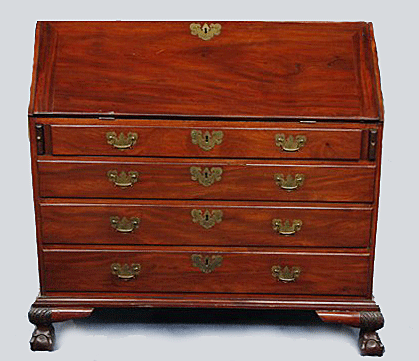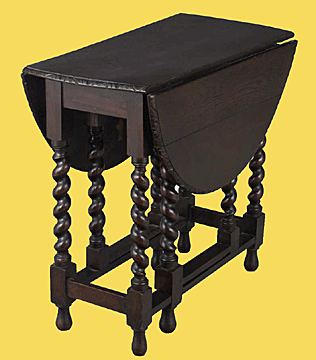|
Patience First
by Bob Brooke
 When
looking at the antiques and collectibles markets today, perhaps it’s
appropriate to paraphrase the name of one of the recent urgent-care
centers, Patient First, by saying “patience first”—because that’s what
it takes to play the antiques game. When
looking at the antiques and collectibles markets today, perhaps it’s
appropriate to paraphrase the name of one of the recent urgent-care
centers, Patient First, by saying “patience first”—because that’s what
it takes to play the antiques game.
As a player, you’ll be on one of two sides. On one side are the antiques
investors and on the other side the antique collectors. There’s a big
difference in the two sides. So pick a side and let’s play the game.
To begin, both players begin with the same amount of money and must
purchase the same group of antiques from their local antiques dealers.
Let’s say the group includes a Chippendale desk, a Victorian gateleg
table, a Wedgewood plate, a Mission rocker, and a peachblow art glass
vase. The object of the game is to see who will end up with the most
value for their antiques.
 But
before we continue playing the game, we need to understand the
difference between investing and collecting. A person who purchases
antiques as an investment usually has nothing more “invested” in them
but money. Often a third party does the actual buying. The only thing
the investor does is pay for the item and have a place to store or
display it. But the collector invests a lot more, including not only his
or her money, but their time and passion for collecting. And while the
investor has the final say as to whether he or she wishes to add an item
to their collection, the collector is directly involved not only in the
decision to purchase an antique but also in every other facet of the
collecting process. But
before we continue playing the game, we need to understand the
difference between investing and collecting. A person who purchases
antiques as an investment usually has nothing more “invested” in them
but money. Often a third party does the actual buying. The only thing
the investor does is pay for the item and have a place to store or
display it. But the collector invests a lot more, including not only his
or her money, but their time and passion for collecting. And while the
investor has the final say as to whether he or she wishes to add an item
to their collection, the collector is directly involved not only in the
decision to purchase an antique but also in every other facet of the
collecting process.
 As
the game progresses, the market takes a dip, much as it has done today.
The investor gets nervous and tries to sell his Chippendale desk. But he
finds out he can only get half what he paid for it. That means he’ll
lose money on the transaction. So he tries to sell his Mission rocker
and discovers that he can get at least what he paid for it. So he
decides to sell it. With the money he receives for the rocker, he can
either buy another piece of furniture or something else. He rushes out
and buys a Lincoln sofa from the 1860s. But he doesn’t have enough money
from his sale of the rocker and must add a bit more. As
the game progresses, the market takes a dip, much as it has done today.
The investor gets nervous and tries to sell his Chippendale desk. But he
finds out he can only get half what he paid for it. That means he’ll
lose money on the transaction. So he tries to sell his Mission rocker
and discovers that he can get at least what he paid for it. So he
decides to sell it. With the money he receives for the rocker, he can
either buy another piece of furniture or something else. He rushes out
and buys a Lincoln sofa from the 1860s. But he doesn’t have enough money
from his sale of the rocker and must add a bit more.
Meanwhile, the collector is enjoying her original purchases and takes
very good care of them, for condition is all important in the antiques
trade.
 Eventually,
the antiques market regains some of its strength, so the collector
decides to trade up. She takes her peachblow art glass vase and trades
it in on a stained glass lamp to place on a table next to her Mission
rocker. While she gains no money, she does gain light for someone
sitting in her rocker. Eventually,
the antiques market regains some of its strength, so the collector
decides to trade up. She takes her peachblow art glass vase and trades
it in on a stained glass lamp to place on a table next to her Mission
rocker. While she gains no money, she does gain light for someone
sitting in her rocker.
With the market up, the investor decides it might be time to sell his
Victorian gateleg table. This time, he gets more than he paid for this
item. But the extra money isn’t enough to buy another item.
The game continues, but it’s obvious that the collector has something
the investor doesn’t—patience. In the antiques game, it pays to be
patient first. In order for the investor to receive a modest return on
his investment, he needs to wait at least 10 years to sell what he has.
And as with the stock market, which goes up and down daily, so does the
antiques market.
 Lots
of things affect the antiques and collectibles markets. Number one is
supply and demand. The more there are of an item, the lower the price
and the less value it will have. If an item is one-of-a-kind, it, too,
can have a lower value. But it’s only when two or more people want the
same item that it’s value increases quickly. Lots
of things affect the antiques and collectibles markets. Number one is
supply and demand. The more there are of an item, the lower the price
and the less value it will have. If an item is one-of-a-kind, it, too,
can have a lower value. But it’s only when two or more people want the
same item that it’s value increases quickly.
Again, the collector is satisfied to enjoy his antiques and isn’t so
anxious to sell them. She keeps them for a number of years, trading some
of them for better pieces to enhance her collection. In the end, she’ll
end up with more value because she was patient. The antiques she
purchased at the beginning of the game weren’t just old things. They had
a previous life and brought joy into someone else’s life before she
acquired them. Now she’s the temporary owner in hopefully a long line of
owners. When she does try to sell them, she’ll know exactly who wants
them and will get at least what she paid for them, if not a lot more.
So by practicing “patience first” it’s possible to outsmart the antiques
market. But to do that successfully, a collector needs to be aware of
the entire collecting process.
<
Back to Antiques Extra! Archives Next Editorial >
|
